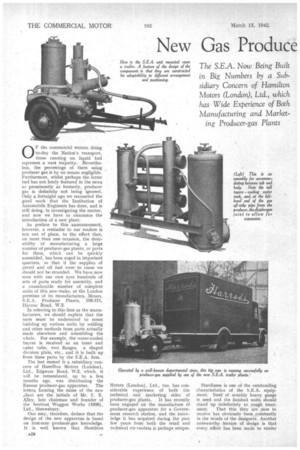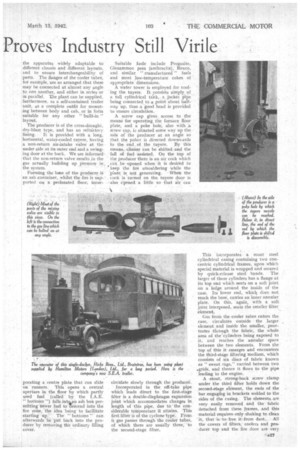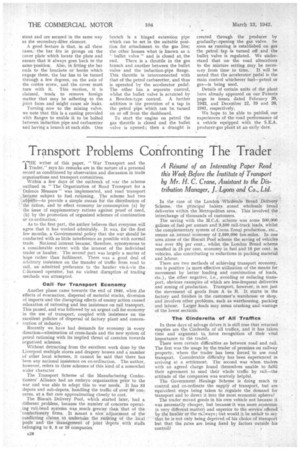New Gas Produce Proves Industry Still Virile
Page 28

Page 29

Page 30

If you've noticed an error in this article please click here to report it so we can fix it.
The SEA. Now. Being Built in Big Numbers by a Subsidiary Concern of Hamilton Motors (London), Ltd., which has Wide Experience of Both Manufacturing and Market
ing Producer-gas Plants
0 F the commercial motors doing to-day the Nation's transport, those runningon liquid fuel represent a vast majority. Nevertheless, the percentage of them using producer gas is by no means negligible. Furthermore, whilst perhaps the latter fuel has not lately featured in the news so prominently as formerly, producer gas is definitely not being ignored. Only a fortnight ago we recounted the good work that the Institution of Automobile Engineers has done, and is still doing, in investigating the matter, and now we have to announce the introduction of a new plant.
As preface to this announcement, however, a reminder to our readers is not out of place, to the effect that, on more than one occasion, the desirability of manufacturing a large number of producer-gas plants, or parts for them, which can be quickly assembled, has been urged in important quarters, so that if the supplies of petrol and oil fuel were to cease we should not be stranded. We have now seen with our own eyes hundreds of sets of parts ready for assembly, and a considerable number of complete units of this new,make, at the London premises of its manufactuters, Messrs. S.E.A. Producer Plants, 169-171, Harrow Road, W.2,
In referring to this firm as the manufacturers, we should explain that the term must be understood to mean building up various units by welding and other methods from parts actually made elsewhere and assembling the whole. For example, the water-cooled tuyere is received as an inner and outer tube, two flanges, a shaped division plate, etc., and it is built up from these parts by the SEA. firm.
The last named is a subsidiary concern of Hamilton Motors (London), Ltd., Edgware Road, W.2, which, it will be remembered, up to a few, months ago, was distributing the Enness producer-gas apparatus. The letters forming the name of the new plant are the initials of Mr. E. E. Alley, late chairmanand founder of the Sentinel Waggon Works (1936), Ltd., Shrewsbury.
• One may,therefore, deduce that the design of the new apparatus is based on first-rate producer-gas knowledge. It is well known that Hamilton Motors (London), Ltd., too, has considerable experience of both the technical and marketing sides of producer-gas plants. It has recently been engaged on the manufacture of producer-gas apparatus for a Government research station, and the knowledge it has acquired during the past few years from both the retail and technical vie.rooints is perhaps unique.
Sturdiness is one of the outstanding characteristics of the S.E.A. equipment. Steel of notably heavy gauge is used and the finished units should stand up indefinitely to rough treat-.
ment. That this they are sure to receive has obviously been constantly in the minds of the designers. Another noteworthy feature of design is that every effort has been made to render the apparatus widely adaptable to different chassis and different layouts, and to ensure interchangeability of parts. The flanges of the cooler tubes, for example, are so arranged that these may he connected at almost any angle to one another, and either in series • or in parallel. 'he plant can be supplied, furthermore, as a self-contained trailer Unit, as a complete outfit for mount.ing between body and cab, or in form suitable for any other "built-in " layout.
The producer is of the cross-draught, dry-blast type, and has no refractory
lining. It is provided with a long, horizontal, water-coded tuyere, having a non-return air-intake valve at the under side at its outer end and a swinging door at the back. We are informed that the non-return valve results in the gas actually building up .pressure in the system.
Forming the be of the procl.ucer,is an ash container, whilst the fire is supported on a perforated floor, it-icor
porating a centre plate that can slide on runners. This opens a central aperture in the floor by which partly used fuel (called by the I.A.E. " bottoms '') fallS inteLan ash box per mitting 'reiver fuel to cend into the fire zone, •the idea being to facilitate
starting up. The " bottanas " canafterwards be put back into the producer by removing the ordinary filling cover.
Suitable fuels include Progasite. Gleriammon peas (anthracite); Rexco, and similar " manufactured " fuels and most low-temperature cokes of appropriate dimensions.
A water tower is employed for cooling the tuyere. It consists simply. of a tall cylindrical taltk, a jacket pipe being connected to a point about halfway up, thus a good head is provided to ensure circulation..
A screw cap gives, access to the means; for operating the furnace floor plate, and a poke hole, also with a screw cap, is situated some way up the side of the producer at an angle so that the poker is directed downwards
to the end of the .tuyere. By this means, clinker Can be shifted and the fail of •fuel assisted. On the tap af the producer there is an air cock which
tan be opened when it is desired to keep the fire smouldering while the plant is not generating. When the cock is turned on the tuyere door is also Cpeiled a little so • that air can circulate slowly through the producer.
Incorporated in the off-take pipe which leads direct to the first-stage filter is a double-diaphragm expansion joint ivhich accommodates changes in length of this pipe: due to the considerable temperature it attains. This first filter 18 Of the cyclone type. From it gas passes through the cooler tubes, of which there are usually three, ' to the second-stage filter.
This incorporates a stout steel cylindrical casing containing two concentric cylindrical frames, upon which special material is wrapped and secured by quick-release steel bands. The larger of these cylinders has a flange at its top end which seats on a soft joint On a ledge around the inside of the case. Its lower end, whiclj, does not reach the base, carries an inner annular plate. On this, again, with a soft joint interposed, seats the smaller filter element.
Gas from the cooler tubes enters the case, circulates outside the larger element and inside the smaller, penetrates through the fabric, the whole area of the'cylinders being exposed to it, and readies the annular space between the two elements, From the tap of this it emerges and encounters the third-stage filtering medium, which consists of six discs of fabric known as " sweat rags," carried between two .grids, and thence it flows to the pipe leading to the engine. A stout, strong-back screw clamp under the third filter holds down the second-stage element, the ends of the bar engaging in brackets welded to the sides of the rasing. The elements .p,re very. easily. removed and the fabric detached from these frames, and this material, requires, only shaking to dean it, that is' to, free it • from dust. All 'the covers of filter%, coolers and produet top and the fire door are very ,427
stout and are secured in the same way as the secondary-filter element.
A good feature is that, in all these cases,the bar fits in prongs on the cover plate which locate the plate and ensure that it always goes back in the same position. Also, in fitting the bar ends to the brackets or• hooks which engage them, the bar has to be turned through a few degrees, on the axis of the centre screw, and the cover must turn with it. This motion, it is claimed, tends . to remove foreign matter that may be adhering to the joint faces and might cause air leaks.
Turning now to the mixing valve, we note that this is a casting provided with flanges to enable it to be bolted between induction pipe and carburetter and having a branch at each side. One branch is a hinged extension pipe which can be set in the suitable position for attachment to the gas line; the other houses what is known as a bullet valve " and is closed at, the end. There is a throttle in the gas branch and another between the bullet valve and the induction-pipe flange. This throttle is interconnected with that of the petrol carburetter, and thus is operated by the accelerator pedal. The other has a separate control, whilst the bullet valve is actuated by a Bowden-type control. A further addition is the provision of a tap in the petrol pipe which can be, turned on or off from the dashboard.
To start the engine on petrol the gas throttle is closed and the bullet valve is opened ; then a draught is created through the producer by graduallr opening the gas valve. So soon as running is established on gas the petrol tap is turned. off and the bullet valve is regulated. We understand that onthe road alterations to the mixture setting may be necessary from time to time. It will be noted that the accelerator pedal is the main control whichever fuel—petrol or gas—is being used.
Details of certain units of the plant have already appeared on our Patents page in issues dated February 20, 1942, and December 12, 19 and 26, 1941, respectively.
We hope to be able to publish, our experiences of the road performance of a vehicle equipped with the S.E.A. producer-gas plant at an early date.




















































